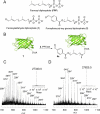Chemoenzymatic reversible immobilization and labeling of proteins without prior purification
- PMID: 22435540
- PMCID: PMC3495177
- DOI: 10.1021/ja211308s
Chemoenzymatic reversible immobilization and labeling of proteins without prior purification
Abstract
Site-specific chemical modification of proteins is important for many applications in biology and biotechnology. Recently, our laboratory and others have exploited the high specificity of the enzyme protein farnesyltransferase (PFTase) to site-specifically modify proteins through the use of alternative substrates that incorporate bioorthogonal functionality including azides and alkynes. In this study, we evaluate two aldehyde-containing molecules as substrates for PFTase and as reactants in both oxime and hydrazone formation. Using green fluorescent protein (GFP) as a model system, we demonstrate that the purified protein can be enzymatically modified with either analogue to yield aldehyde-functionalized proteins. Oxime or hydrazone formation was then employed to immobilize, fluorescently label, or PEGylate the resulting aldehyde-containing proteins. Immobilization via hydrazone formation was also shown to be reversible via transoximization with a fluorescent alkoxyamine. After characterizing this labeling strategy using pure protein, the specificity of the enzymatic process was used to selectively label GFP present in crude E. coli extract followed by capture of the aldehyde-modified protein using hydrazide-agarose. Subsequent incubation of the immobilized protein using a fluorescently labeled or PEGylated alkoxyamine resulted in the release of pure GFP containing the desired site-specific covalent modifications. This procedure was also employed to produce PEGylated glucose-dependent insulinotropic polypeptide (GIP), a protein with potential therapeutic activity for diabetes. Given the specificity of the PFTase-catalyzed reaction coupled with the ability to introduce a CAAX-box recognition sequence onto almost any protein, this method shows great potential as a general approach for selective immobilization and labeling of recombinant proteins present in crude cellular extract without prior purification. Beyond generating site-specifically modified proteins, this approach for polypeptide modification could be particularly useful for large-scale production of protein conjugates for therapeutic or industrial applications.
Figures












References
-
- Zhu H, Bilgin M, Bangham R, Hall D, Casamayor A, Bertone P, Lan N, Jansen R, Bidlingmaier S, Houfek T, Mitchell T, Miller P, Dean RA, Gerstein M, Snyder M. Science. 2001;293:2101–2105. - PubMed
-
- Luk Y-Y, Tingey ML, Dickson KA, Raines RT, Abbott NL. J. Am. Chem. Soc. 2004;126:9024–9032. - PubMed
-
- Weinrich D, Lin P-C, Jonkheijm P, Nguyen UTT, Schröder H, Niemeyer CM, Alexandrov K, Goody R, Waldmann H. Angew. Chem. Int. Ed. 2010;49:1252–1257. - PubMed
-
- Zhong M, Fang J, Wei Y. Bioconjugate Chem. 2010;21:1177–1182. - PubMed
-
- Lin P-C, Ueng S-H, Tseng M-C, Ko J-L, Huang K-T, Yu S-C, Adak AK, Chen Y-J, Lin C-C. Angew. Chem. Int. Ed. 2006;45:4286–4290. - PubMed
Publication types
MeSH terms
Substances
Grants and funding
LinkOut - more resources
Full Text Sources
Other Literature Sources

